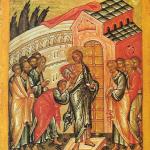We can never afford to lose our love and compassion for every man and woman and child. That is so much of the message of the Gospel — of God’s love and mercy for us — that Pope Francis has been pleading with us to truly surrender our lives to.
Tuesday morning in his tweet, Pope Francis instructs:
Dear young people, Jesus gives us life, life in abundance. If we are close to him we will have joy in our hearts and a smile on our face.
— Pope Francis (@Pontifex) February 4, 2014
On January 22, we marked the 41st year since the Supreme Court’s Roe v. Wade ruling that made abortion legal in the United States throughout pregnancy. Young people flooded the U.S. capital in prayer and study and in celebration of life.
When Pope Francis cautions against obsessing about certain issues, it’s these young people who can be models for us. As you can see from some of the photos I snapped along the March for Life route, they are full of joy — even while freezing. There is an integrated faith with a joy for life, and a desire to help women, help families, and yes, defend the defenseless.
In a few recent interviews, I asked different people in different walks of life about abortion and its poisonous effect on the lives of the living, on reason and equality, on civil rights, on history, on scientific inquiry, and on our notions of women’s health, on our language, blinding us to exploitation.
These are challenges of our day. To defend life, always — fully — in no small part by living integrated lives of faith.
I was struck by the wisdom of young women Jennifer Manning, a schoolteacher with Catholic Voices USA, travelled with for the March for Life, from Boston.
One of her high-school students, Carol observed while thawing:
Being pro-life is not just about babies, it’s a lifestyle. It’s about seeking out the people who are ostracized, people who are suicidal, victims of the death penalty — showing them that there is love and support and that this life is worth living.
That’s what we need to convey, always. For the sake of the unborn and elderly. For immigrants. For the unemployed. For the forgotten. For the desperately tortured, like a young man in Washington, D.C., who just took his life.
In an interview last month, New York’s Cardinal Dolan talked with me about how inspiring he finds the March for Life:
It is a grim anniversary. It’s a somber anniversary. But it’s almost become like a Good Friday. There’s Good Friday — why do we call it “good”? The worst thing in the history of the world happened on that day. The Son of God was crucified. But good came of it. That’s what I was saying about January 22. It’s a morbid, somber, sad, tragic anniversary, but now we see resurrection coming from it, as we see hundreds of thousands of committed people joining the march.
It gets bigger and bigger every year, and the crowd gets younger and younger every year — more articulate, more passionate — saying we must reclaim our American birthright. We must reclaim the idea that everybody has equal protection under the law, even the baby in the womb.
This is something exciting. This is something exhilarating. This is something inspirational that we see going on.
In the midst of suffering, Christians are called to be a balm, an invitation to mercy and love, reaching out, as the pope puts it, to the peripheries. That’s online, that’s offline, that’s challenging us to never stay in comfortable categories or routines. We’re called to a life of radical encounter — born and nourished by encounter with Christ, bringing people to Christ. When we understand that, we will have no obsessions (Cardinal Dolan talks about this, too, in the interview), but live in Christ’s self-sacrificial love, in countercultural courage.















